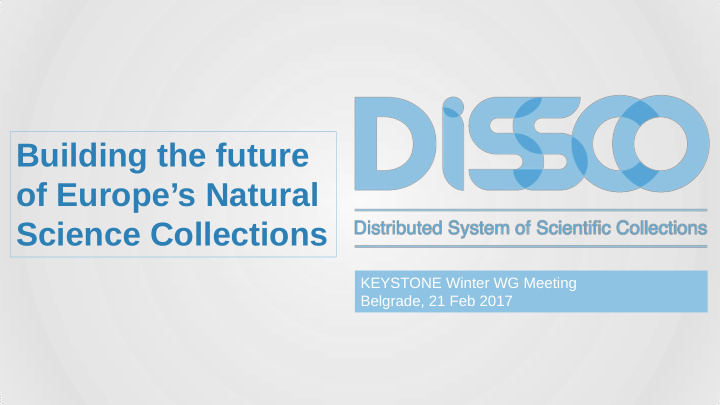



Building the future o f Europe’s Natural Science Collections KEYSTONE Winter WG Meeting Belgrade, 21 Feb 2017
Goal Join forces in Europe to connect 1.5 billion biological and geological collection objects representing 4.5 billion years of the Earth's history, with 21st century science Natural Science Collections, sometimes referred to as the Cathedrals to nature , will be transformed into Cathedrals of data, knowledge and expertise .
Desirable result: a comprehensive knowledge framework The Research Infrastructure will enable collections to be integrated with other sources of information, uniting phenotypic and genetic data across temporal, geospatial and taxonomic frameworks . Size and complexity of the structured data will make DiSSCo an interesting dataset for research by KEYSTONE participants
Development Pillars The development of DiSSCo will rely on three pillars: • Digitising and mobilising content from Collections through open access, comprehensive tools and innovative services • Harmonising data policies, processes and workflows • Maximising the use of expertise, enhancing skills and engaging communities
Consortium building Austria Belgium Bulgaria 19 National Task Forces (NTF) Czech Republic Germany Denmark Estonia Spain Finland France Greece Italy Netherlands Norway Poland Portugal Sweden Slovakia United Kingdom
Development timeline Deadline for submission of Proposal to ESFRI August Announcement of 2018 2017 DISSCO ERIC set-up ESFRI roadmap May 2024 Q4 2018 2016 2017 2018 2019 2020 2021 2022 2023 2024 2025 Today Consortium & Proposal development Innovation Programme Consolidation Programme Construction Programme Operational Phase
Connect the old with the new Make validated links between the traditional knowledge base of centuries of biological collections and literature ordered by taxonomic names - with the databases holding the DNA barcodes .
Species names as keywords - domain background information Keywords commonly used for Biodiversity data: Species name or common name/vernacular in a certain language and locality, or group of species (taxon). Species can also be subdivided in closely related lower taxa, like a subspecies or a variety. A species name is in Latin and has 2 parts , example: Ursus maritimus (common name: Polar Bear in English). Ursus is the genus to which the species belongs, so if the species is moved to another genus because of a new taxonomic opinion, the species name will change as well. The specific epithet maritimus may change also depending on gender of the genus name. Animal names have different nomenclature rules from plants. A scientific name label represents an opinion on a taxon concept, it is not a unique identifier for the taxon concept. A taxon concept is delimited by a description and circumscribed by specimen, which have identifications (a scientific name attached to the specimen at a certain point in time).
From Names to Taxon Concepts From: The use and limits of scientific names in biological informatics D. Remsen http://zookeys.pensoft.ne t/articles.php?id=6234
Catalogue of Life Plus GBIF Implementation Plan 2017-2021 Activity 2b - Deliver names infrastructure Need: comprehensive checklist of known species, and their published scientific names (keywords) to search in structured biodiversity data. 2017-2018: Joint investment by NLBIF, Naturalis, GBIF, Catalogue of Life to build: ● a shared taxonomic backbone that serves global biodiversity data aggregators and users; ● a jointly developed and maintained, open and user-friendly taxonomic index with keywords to organize biodiversity data and separation between nomenclature (syntax) and taxonomy (semantics) Catalogue of Life Plus & DiSSCo together will result in organized biodiversity information
Catalogue of Life Plus - name resolution process Name resolution process in 3 steps: 1. Lexical name resolution to normalize spelling of scientific names, 2. Nomenclatural name reconciliation to find the original nomenclatural event (protonym) as well as the nomenclatural history of a name, and 3. Taxonomic name resolution that presents a specialist opinion in selecting a currently accepted scientific name for a particular taxa.
Keyword-based search related research topics Examples: • Extract scientific names & common names from text (semi-structured published species descriptions) • Resolve scientific names and common names to currently accepted name • Optimized results ranking: searching for (genus) Accipiter should first return documents with exact match Accipiter , not give Accipiter accipiter a higher ranking • Latin grammar algorithms: in results there should be no difference between male and female endings Pterostyrax hispida and Pterostyrax hispidus • Use of traits (characters and their states) as keywords: search for 'round leaf' should return species or specimen with a round leaf • Extract keywords from specimen multimedia (image recognition, handwriting recognition) • Search by distribution while locality is recorded as verbatim text, like ‘Coimbra‘ and the specimen found centuries ago
What will improved keyword search bring DiSSCo Transform the collection datasets to one integrated European Example research questions to facilitate: • Predict if, given a certain habitat, a species is virtual collection introduced, that will cause competition for native integrated with other species and how likely it is that it will be introduced there by humans or other vectors. sources of information, • Predict that given a temperature rise of 1 degree Celsius a species distribution will change or it will uniting phenotypic and become extinct. genetic data across • Find likely hosts for an insect given the distribution for that insect and other data. temporal, geospatial and taxonomic frameworks.
Recommend
More recommend